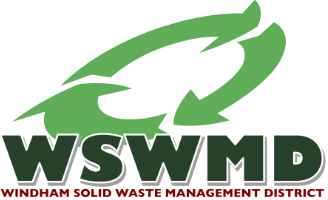 The Windham Solid Waste Management District (WSWMD) was formed in 1988. At that time, only eight towns were members of the District. These towns cooperatively managed a 30-acre landfill. In 1995, federally mandated landfill operation regulations forced WSWMD to seek alternative landfill sites or an alternative to landfill disposal. After much discussion, WSWMD decided to exit the landfill business and focus on recycling. In 2017, the Materials Recovery Facility (MRF) was closed for most recycling processes, except for cardboard baling. In 2018, the landfill cap was converted to 21 acres of solar panels. Follow this link to learn more about the WSWMD Solar Array.
The Windham Solid Waste Management District (WSWMD) was formed in 1988. At that time, only eight towns were members of the District. These towns cooperatively managed a 30-acre landfill. In 1995, federally mandated landfill operation regulations forced WSWMD to seek alternative landfill sites or an alternative to landfill disposal. After much discussion, WSWMD decided to exit the landfill business and focus on recycling. In 2017, the Materials Recovery Facility (MRF) was closed for most recycling processes, except for cardboard baling. In 2018, the landfill cap was converted to 21 acres of solar panels. Follow this link to learn more about the WSWMD Solar Array.Our Mission
“The Windham Solid Waste Management District’s (WSWMD) mission is to provide solid waste education, recycling management, and disposal services for its member’s towns and other entities as needed.” This means the WSWMD is responsible for providing public education programs on all aspects of solid waste and hazardous waste management to member communities, and collection and diversion services for all wastes banned from Vermont landfills. In 1995, the WSWMD adopted the following goal: “Each item of waste generated within the District (should) be directed to the highest level of the solid waste management hierarchy as is possible.” The WSWMD’s headquarters are based on Old Ferry Road in Brattleboro, Vermont where it maintains the following:
- A 30-acre closed landfill that was among the first in the nation to use its methane gas to generate electricity
- A 21-acre solar array, maintained by Greenbacker Capital
- A compost facility for processing food scraps, a drop-off facility for compostable materials and yard waste
- A backyard compost demonstration area for workshops, and a display of compost bins available for sale
- A transfer station that accepts non-recyclable solid waste (often called Municipal Solid Waste, or MSW), construction and demolition (C&D) debris, and scrap metal
- A drop-off facility (recycling drop-off center) for glass, cardboard, commingled containers (paper, plastic)
- A drop-off facility for special recycling programs: Waste oil, tires, batteries, textiles, appliances (white goods), scrap metal, books, computers, and other electronic waste, and seasonal drop-off for hazardous waste (visit the HHW Depot).
- A Swap Shop for reusable items that still have life left in them
- District offices that house the District administrative staff
